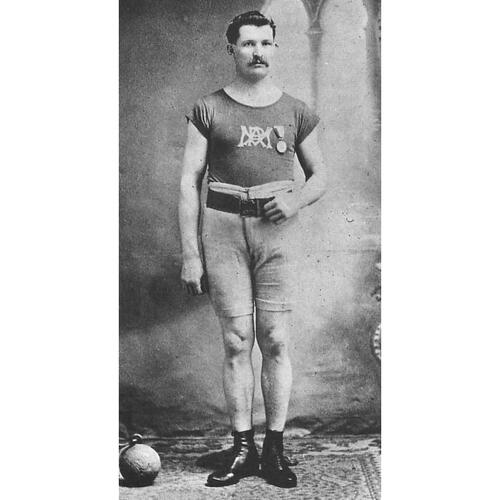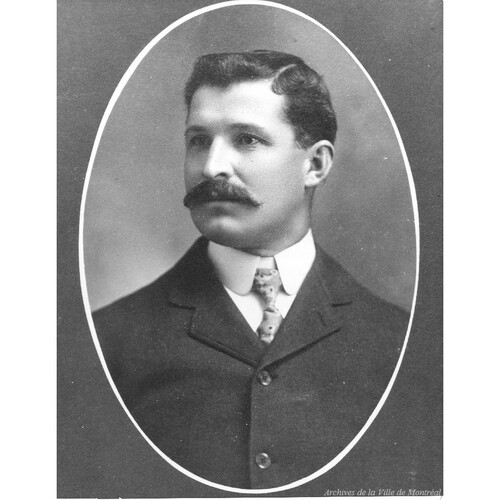![Description English: Étienne Desmarteau Français : Le champion olympique Étienne Desmarteau. Année: 1904. Auteur: inconnu. Commanditaire: Alexandra Studio. Référence: Alexandra Studio Date 1904 Source [1] Author Anonyme
Original title: Description English: Étienne Desmarteau Français : Le champion olympique Étienne Desmarteau. Année: 1904. Auteur: inconnu. Commanditaire: Alexandra Studio. Référence: Alexandra Studio Date 1904 Source [1] Author Anonyme](/bioimages/w600.3679.jpg)
Source: Courtesy of Wikimedia Commons
DESMARTEAU, ÉTIENNE (baptized Joseph-Étienne Birtz), labourer, policeman, and athlete; b. 4 Feb. 1873 in Boucherville, Que., son of Étienne Birtz, a farmer, and Caroline Dubuc; d. unmarried 29 Oct. 1905 in Montreal, and was buried on 31 October in Boucherville.
The first member of the Birtz family to come to New France arrived around 1750 with the Régiment de Béarn. After the conquest of the colony by Great Britain, this Étienne Birtz resumed his trade as a blacksmith. Since his shop was marked by a sign bearing two crossed hammers, he was given the name Desmarteaux. In place of the plural form, his descendants preferred the singular, Desmarteau.
After Étienne Desmarteau, the second of seven children, was born, the family left Boucherville and moved to Montreal. Étienne does not seem to have been fond of attending school when he was young. Later he was employed by the Canadian Pacific Railway as a metal-caster and then in 1901 he became a policeman in Montreal. Six feet tall and weighing 208 pounds, he distinguished himself by two known acts of bravery. The first occurred in 1902, when he arrested someone preparing to set fire to a store in which there were four young children and their parents. The second came in 1905, when he arrested a thief presumed to be dangerous. Desmarteau was considered a model policeman, always on good terms with his colleagues. He was sometimes sharp-tongued, however, as can be seen by the complaint brought against him in 1905 after a demonstration during which he reportedly hurled abuse at one of his superiors.
Desmarteau went down in history because of his physical strength. In 1902 he ranked first in the world junior and heavyweight hammer-throwing championships. But he is remembered for his victory at the 1904 Olympics in St Louis, Mo., when he managed a throw of 34 feet 4 inches in the 56-pound weight contest. He was long regarded as the first Canadian to have earned a gold medal, although not all experts agree. Some claim the honour belongs to George Orton, who had won the 2,500-metre steeplechase in Paris four years earlier. Orton, a Canadian by birth, was, however, wearing the colours of the United States, where he was studying. Others maintain that Desmarteau should be considered the first since George Seymour Lyon*’s victory in the golf competition at St Louis in 1904 ought to be disregarded, golf having been included in the Olympic Games only that one time. In any case Étienne Desmarteau certainly was the first French Canadian to receive an Olympic gold medal.
Desmarteau nearly missed his date with fame, when permission to participate in the St Louis games was refused him by the Montreal police. Although his superiors would not grant him an unpaid leave of absence, he went to St Louis anyway under the banner of the Montreal Amateur Athletic Association, and on returning covered with glory, he was immediately rehired. He won his fame in the midst of what was then considered a “big circus,” during which various groups, Sioux, Patagonians, Pygmies, and Moros among others, held their own games, dubbed Anthropological Day.
At St Louis, as at Paris in 1900, the Olympic Games lost the esteem of their supporters and of the general public. The 1900 games had suffered from being linked with the universal exposition being held in the French capital; the same mistake was made in 1904, since the games were held in conjunction with the Louisiana Purchase exposition in St Louis. Moreover national and international events took the headlines in the summer of 1904. What with the presidential election campaign in the United States and interest in the Russo-Japanese War, which was at its height, the Olympic Games attracted little attention.
Athletes from eight countries, or, according to some sources, eleven, took part in the St Louis games, including contestants from the United States and Canada. With more than 1,500 athletes (nearly half the total number), the Americans carried off 20 of the 21 medals awarded in track and field. Desmarteau alone succeeded in breaking this monopoly. Although not triumphal, his arrival back in Montreal was greeted with demonstrations of joy. La Presse described him as the “champion of the universe, whose comrades at Station 5, on Rue Chenneville, were getting ready for a great show . . . to celebrate his victorious return.” The following year he achieved another success in the Montreal police field events; on 26 July 1905 he set a new world record for the 56-pound high-throw, reaching 15 feet 9 inches.
A few months later, at the age of 32, Étienne Desmarteau died in Montreal, where he was training for a competition. He was probably a victim of typhoid fever. In the period leading up to the 1976 Olympic Games, which were held there, the city honoured him by giving the name of Étienne Desmarteau to an athletic centre and to a park in Rosemont previously known as Drummond Park. He had already been elected to Canada’s Sports Hall of Fame in 1955.
AC, Longueuil, État civil, Catholiques, Sainte-Famille (Boucherville), 31 oct. 1905. ANQ-M, CE1-22, 4 févr. 1873. AVM, D1901.1; R3058.2 (adresse civique 3430); Dossiers de personnel, Étienne Desmarteau. La Presse, 2 sept. 1904: 3; 6 sept. 1904: 1; 30 oct. 1905: 12. Canadian encyclopedia. Roger de Groote, Le livre des jeux olympiques (Paris, 1972), 34–36. É.-Z. Massicotte, Athlètes canadiens-français; recueil des exploits de force, d’endurance, d’agilité, des athlètes et des sportsmen de notre race depuis le XVIIIe siècle; biographies, portraits, anecdotes, records (2e éd., Montréal, [1909]). H. [H.] Roxborough, Canada at the Olympics (3rd ed., Toronto, 1975), 24, 27, 192.
Cite This Article
Gaétan Sanfaçon, “DESMARTEAU, ÉTIENNE (baptized Joseph-Étienne Birtz),” in Dictionary of Canadian Biography, vol. 13, University of Toronto/Université Laval, 2003–, accessed January 2, 2026, https://www.biographi.ca/en/bio/desmarteau_etienne_13E.html.
The citation above shows the format for footnotes and endnotes according to the Chicago manual of style (16th edition). Information to be used in other citation formats:
| Permalink: | https://www.biographi.ca/en/bio/desmarteau_etienne_13E.html |
| Author of Article: | Gaétan Sanfaçon |
| Title of Article: | DESMARTEAU, ÉTIENNE (baptized Joseph-Étienne Birtz) |
| Publication Name: | Dictionary of Canadian Biography, vol. 13 |
| Publisher: | University of Toronto/Université Laval |
| Year of publication: | 1994 |
| Year of revision: | 1994 |
| Access Date: | January 2, 2026 |





